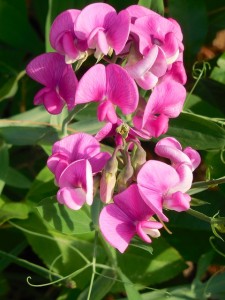Sweet Peas & Strawberries
Question from Gerry:
 For three years I’ve meant to grow sweet peas, but something has gotten in the way until this year. I remembered to plant sweet peas in September–spent August prepping a 35′ row, sowed on Labor Day. Didn’t review your book. Didn’t soak the seed. They came up sporadically, but I never seemed to have more than a half dozen seedling up at a time. Went out yesterday to discover there were NO seedlings. Went to the office, opened your book, discovered two very important details: soak the seed and protect from birds (the Cereus peruvianus have ripe fruit now, and the Cereus hedge is full of birds eating–and noting what else is in the neighborhood).
For three years I’ve meant to grow sweet peas, but something has gotten in the way until this year. I remembered to plant sweet peas in September–spent August prepping a 35′ row, sowed on Labor Day. Didn’t review your book. Didn’t soak the seed. They came up sporadically, but I never seemed to have more than a half dozen seedling up at a time. Went out yesterday to discover there were NO seedlings. Went to the office, opened your book, discovered two very important details: soak the seed and protect from birds (the Cereus peruvianus have ripe fruit now, and the Cereus hedge is full of birds eating–and noting what else is in the neighborhood).
Today I’ll prep a chicken wire enclosure and this evening I’ll soak the seeds: tomorrow morning is the start of a new crop! So much for sweet peas for Christmas. Now I’ll have them for the New Year.
In early August I noted the strawberries weren’t sending out runners and the plants looked “pinched”. I put light shade over them, salted with Ammonium sulfate, mulched, and upped the watering. Within a month they were lush, and the first runner appeared. In a couple of weeks I’ll harvest plants. While they are in the refrigerator their raised bed will have 4″ of compost tilled-in and a better irrigation system installed (I’m going to run soaker hoses down each row and hook the manifold up to one of the timer stations–I’ve had enough hand-watering to last 3 lifetimes). After 3 seasons of so-so results, I look forward to lots of yumminess next spring.
As always, thanks for an encyclopedia of a lifetime’s experience and research.
Answer from Pat:
Thanks so much for your kind comments on the sweet pea info in my book and also strawberries. First regarding sweet peas. In addition to the items you mention I would like to add another fact from my book and that is that when we want “armloads of sweet peas for Christmas” we must plant “early” varieties or “winter varieties, such as ‘Winter Elegance’. This variety was developed in America for the cut flower industry. It is day-length neutral. “Late” varieties and “old-fashioned” or “Old English” varieties were all developed for English conditions where they plant in early spring and the flowers bloom in May due to daylength and temperature. If you choose to plant late, old fashioned , or English varieties, even if you plant them in early September, they will not bloom until May since they are programmed to be vegetative during the short day months. Planting these varieties early is a big waste of garden space during winter. One could put another crop such as broccoli in that row and harvest it out then plant the sweet peas on March 1 and enjoy the flowers in May. I do not do this because sweet peas are best adapted to cool weather and then one can enjoy several winter and spring months of bloom.
And yes, birds often sit in one plant or tree and notice everything else going on in the garden! I used to have a Mockingbird who simply adored watching me garden. He would sit in a tree and watch me plant wildflowers. If I failed to cover my seedbed carefully with staked-up bird netting held down with rocks on the edges, he would swoop down as soon as my back was turned to feast on the results of my labor.
Your strawberry bed sounds great, but please try to get the plants (pre-chilled 6 weeks) and into the ground by November 11 at the latest. This is because of day-length and temperature that leads to early fruiting. I would prefer organic fertilizer to sulfate of ammonia, but you know I am an organic gardener.
All the best and many thanks for writing!

